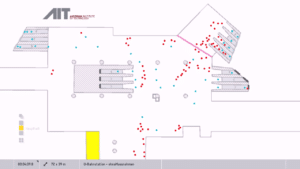The New Virtual Reality: How Simulations Can Help Manage Mobility Systems
How simulations can help to manage mobility systems during and after the COVID-19 crisis, by Dr Stefan Seer and Dr Johannes Müller
The movement of people as individuals, in groups or even in crowds, is dynamic and it is therefore difficult to predict the implications of different measures. At the same time, the risk of "trial-and-error" is very high, especially in the perspective of COVID-19. Using AIT’s pedestrian simulation tool SIMULATE [1], we can predict and analyse the flow of people under various structural and organizational measures. This enables us to evaluate the effectiveness of measures which are implemented to ensure that minimum safety distances between people can be maintained.
For example, we were able to show in the microscopic simulation of customer flows in a supermarket that reducing the customer frequency by half together with a one-way system, instead of a random sequence of shelf visits, has a strongly positive effect on contact times (i.e. the time during which the distance between people is less than 1 metre). If no measures are taken, almost everybody is in contact with other people for more than three minutes. With measures in place, 62% of all customers are in contact for less than 10 seconds, 83% for less than 20 seconds and 90% for less than 30 seconds.

Figure 1a: Simulation of passenger flows in a metro station without measures.

Figure 1b: Simulation of passenger flows in a metro station using measures to separate the flow of people (circles represent people; red circles show people whose distance to the next person is less than 1m).
We have also demonstrated similar positive effects on the reduction of contact times in the simulation for measures to manage and segregate the passenger flows in metro stations (see Figures 1a and b). By cleverly changing the access to platforms, the use of escalators and walkways when changing trains, the contact times of passengers can be greatly reduced. From an average of 50 seconds before to less than five seconds after implementing the measures (see Figures 2 a and b) without increasing transfer times in the station significantly. This confirms that pedestrian simulations can support the efficiency of current measures as well as examine and propose new strategies to enhance their effectiveness and reduce possible risks in case of gradual restoration of our daily activities.

Figure 2a: Distribution of contact times (i.e. time during which the distance between persons is less than 1 meter) in the metro station without measures

Figure 2b: Distribution of contact times (i.e. time during which the distance between persons is less than 1 meter) in the metro station using measures to separate the flow of people.


